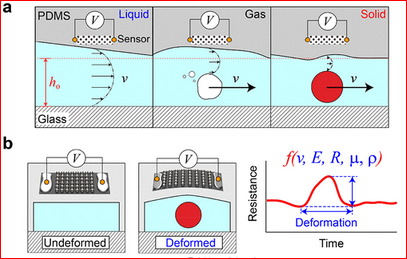Microfluidic Device: Optics-Free, Non-Contact Measurements of Fluids, Bubbles, and Particles in Microchannels
Background
Microfluidic devices have long been touted as a powerful analytical tool with which to characterize a wide range of analytes, including particles, and cells. Despite the apparent convenience of microfluidic technologies for applications in healthcare, such devices often rely on capital-intensive optics and other peripheral equipment that limit throughput, perhaps because the majority of microfluidic devices operate using optics-based principles, which typically require high-speed or sensitive cameras, sophisticated confocal microscopes, vibration isolation tables, and laser excitation systems.
Technology Description
Researchers at UC San Diego have developed have developed a technology to monitor the transit of fluids, gases, particles, and cells as they flowed through a microfluidic channel without the use of a camera or laser, i.e., "optics-free" microfluidics. This invention leverages the ability to monitor the deformation of the side walls caused by the analyte passing through the channel. Critically, the analyte did not have to make contact with the channel walls to induce a deflection. This minute deformation was transduced into a change in electrical resistance using an ultrasensitive piezoresitive film composed of metallic nano-islands on graphene.
Applications
Using this technology UCSD nanoengineers could demonstrate that the deformation of the sidewalls in a microfluidic channel may be used to measure a variety of phenomenon, such as the fluid flow rates, the viscoelastic relaxation of the channel side walls in the presence of air bubbles, and channel deformation caused by particles and cells.
This technology can be incorporated into many existing flow systems, such as flow cytometry and allow the measurement of cellular properties that are not possible with flow cytometric analysis using fluorochrome conjugated antibodies. It may enable new avenues of investigation in physics and biology. These devices can be deployed to experimentally verify novel elastohydrodynamic phenomenon, such as the passage of deformable particles in the presence of deformable walls, or the flow around a deformable junction in the channel.
Advantages
This invention provides low-cost, but ultra-sensitive, metal nanoislands-ongraphene strain sensors to transduce wall deformation events into information about the flow and particles inside the microfluidic channel. For example, this device may provide a method of continuously measuring the mechanical properties of cells, and more specifically, this capability could be advantageous in the high-throughput screening of cells that differ in mechanical properties only, such as the label-free detection of circulating tumor cells. Furthermore, the apparatus is suitable for use on a regular benchtop with a simple voltage reading.
State Of Development
The state of development is at the working prototype stage.
Intellectual Property Info
UC San Diego is seeking help from companies to help commercialize this technology in instruments using this patent-pending technology.
Related Materials
Patent Status
| Country | Type | Number | Dated | Case |
| Patent Cooperation Treaty | Published Application | WO 2019/195618 | 10/10/2019 | 2018-283 |
Contact
- University of California, San Diego Office of Innovation and Commercialization
- innovation@ucsd.edu
- tel: View Phone Number.
Other Information
Keywords
Microfluidic device, high-throughput, analyte, microfluidic channel, strain sensor, bubbles elastohydrodynamics; viscosity, graphene, particles, viscous fluids, biological cells
